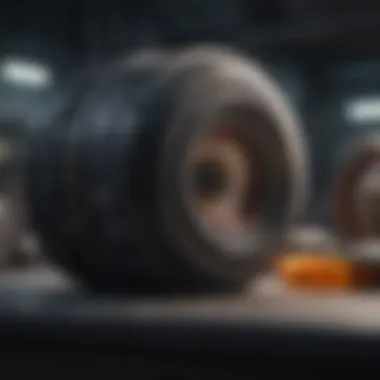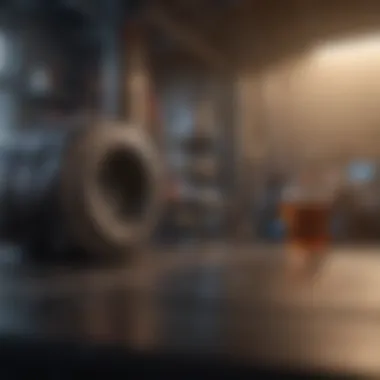Exploring 3D Printing: Unleashing Creative Potential


Intro
3D printing, also known as additive manufacturing, stands at the forefront of technological evolution. It has transitioned from a niche interest within engineering circles to a pivotal force shaping various sectors including healthcare, automotive, and consumer goods. This transformation is not just about creating objects; it is about redefining manufacturing, creativity, and innovation itself. Understanding the potential of 3D printing is crucial as it allows individuals and industries to push boundaries that were once thought impossible.
This article aims to explore the diverse applications of 3D printing. By examining potential projects ranging from everyday items to complex technologies, we strow a light on the technology's capabilities. An in-depth analysis of materials used, implications for innovation, and challenges faced in this rapidly developing field will also be discussed, providing a holistic view tailored for those engaged in intellectual discourse around this topic.
Intro to 3D Printing
3D printing has emerged as a transformative technology across various sectors, acting as a bridge between digital design and physical creation. It allows individuals and organizations to realize complex geometries that traditional manufacturing methods cannot easily produce. This introduction sets the stage for a deeper understanding of what 3D printing entails, its evolution, and its multifaceted applications. Engaging with this topic is essential for students, researchers, educators, and professionals alike, as it underpins innovations that are reshaping industries.
Definition of 3D Printing
3D printing, also known as additive manufacturing, involves creating three-dimensional objects from a digital file. The process generally starts with designing a 3D model using computer-aided design (CAD) software. Once a design is finalized, the 3D printer fabricates the object by adding material layer by layer until the final product is achieved. Materials used in this process can range from plastics and metals to ceramics and biological substances, catering to a wide range of applications.
History and Evolution
The origins of 3D printing can be traced back to the early 1980s when Charles Hull invented stereolithography, the first 3D printing technology. Over the subsequent decades, 3D printing evolved through innovations such as selective laser sintering and fused deposition modeling. Each development broadened the technology's potential, allowing it to gain traction beyond prototyping. By the 2000s, 3D printing began to enter commercial spaces, revolutionizing sectors like aerospace, automotive, and healthcare. Today, with advancements in materials and techniques, 3D printing is recognized not only for its utility but also for its potential to drive sustainability and customization in production.
"3D printing has democratized innovation, allowing creators to produce simply and versitile interesting designs."
The exploration of 3D printing is a journey through its rich history and transformative impact. It lays the groundwork for understanding its applications and future potential.
Materials Used in 3D Printing
Understanding the materials that are employed in 3D printing is crucial. The choice of material affects the properties of the final printed product, including strength, flexibility, durability, and even cost. Familiarity with these materials opens up new possibilities for design and function. This section explores common materials, advanced options, and sustainability considerations that impact the use of 3D printing technology.
Common Materials
Three-dimensional printing works with a variety of materials, each having distinct features.
- PLA (Polylactic Acid): This biodegradable plastic is popular for its ease of use. PLA filament is derived from renewable resources like corn starch. It is suitable for a range of applications but is less durable than other materials.
- ABS (Acrylonitrile Butadiene Styrene): Known for its strength and heat resistance, ABS is often used in functional parts like tools and automotive components. It requires higher printing temperatures, which can complicate the process.
- PETG (Polyethylene Terephthalate Glycol-modified): This material strikes a balance between durability and ease of use. It’s known for its chemical resistance and is often utilized for containers.
These materials cater mainly to hobbyists and industries looking to prototype or create simple designs.
Advanced Materials
As the field of 3D printing evolves, advanced materials have emerged to address more complex needs.
- Nylon: This material is known for its high tensile strength and flexibility. It is suitable for parts that must endure stress, making it a favorite in machinery components.
- Resins: Often used in SLA (Stereolithography) printing, resins can be formulated for specific applications such as tough, flexible, or castable materials.
- Metal Filaments: These filaments, which include metals mixed with plastic, allow for the creation of metallic objects with 3D printers. They offer the aesthetic and physical properties of metal and are commonly used for intricate designs.
Each advanced material brings unique properties essential for more specialized applications, often seen in high-tech industries like aerospace and automotive.
Sustainability in Materials
Sustainability is becoming an increasingly important consideration in material selection. The production and disposal of traditional materials can have negative environmental impacts.
- Biodegradable options: PLA is an example of a biodegradable material that reduces waste. It can compost, breaking down over time in the right conditions.
- Recyclable materials: Some 3D printing filaments can be recycled, including certain types of PET and ABS, reducing the overall environmental footprint.
- Efficient production: 3D printing itself can reduce waste compared to traditional manufacturing processes that often involve cutting away material.
"The materials used in 3D printing not only affect the outcome of individual projects but also play a pivotal role in the larger conversation about sustainability in modern manufacturing."
Choosing the right materials is not only about functionality but also about understanding their impact on both design and the environment. By considering these factors, designers and engineers can better align their 3D printing projects with ecological considerations.
Practical Household Items
The advent of 3D printing technology has redefined what can be created for everyday use in our homes. This section delves into the realm of practical household items that can be built using 3D printing. These items not only enhance functionality but also reflect individual creativity and personalization. As we traverse this topic, we will examine the benefits and specific elements of practical household items that 3D printing can provide.


3D printing allows for the creation of customized items to suit personal needs. The technology facilitates the production of goods on demand, meaning people can print what they need when they need it. This reduces waste and can potentially lower costs in procurement. Moreover, the ability to create bespoke items fosters an environment of innovation and creativity. By designing unique pieces that are tailored to specific requirements, individuals can transform their living spaces in meaningful ways.
Kitchen Utensils
In the kitchen, 3D printing offers a wealth of possibilities for creating utensils that are both functional and novel. Items such as measuring cups, spatulas, or even cookie cutters can be precisely designed to meet personal cooking and baking styles. The ability to incorporate specific sizes or unique shapes can enhance the cooking experience.
Some key benefits of 3D printed kitchen utensils include:
- Customization: Users can design items to match their kitchen aesthetics.
- Practicality: Printing utensils that fit comfortably into one's hand can improve usage efficiency.
- Functionality: Specialized tools can be created for unique cooking methods.
Considerations include ensuring the materials used are food-safe and durable enough to withstand daily use.
Home Decor
Home decor is another significant area where 3D printing shines. Items such as vases, picture frames, or figurines can be tailored to fit personal styles and colors. The ability to print-on-demand means individuals can refresh their home decor as often as they like. This flexibility in design can instill a sense of uniqueness within a space.
The advantages of 3D printed home decor are numerous:
- Endless Designs: Users have virtually limitless options for design.
- Cost-Effective: Creating custom pieces can be more affordable compared to traditional retail options.
- Personal Touch: The process encourages creativity and individuality, making homes more personal.
A few considerations when utilizing 3D printing for home decor would be material choice and structural integrity to avoid potential breakage.
Organizers and Storage Solutions
Utilizing 3D printing to create organizers and storage solutions addresses a common challenge: clutter. Custom storage bins, drawer dividers, and even cable organizers can be designed precisely for one’s needs. These solutions can lead to a more organized and efficient living environment.
Benefits of 3D printed organizers include:
- Tailored Fit: Items can be designed to fit specific spaces, maximizing area usage.
- Versatility: Users can create organizers for a variety of purposes, from office supplies to kitchen pantry items.
- DIY Solutions: Individuals can learn to design and produce their own storage items, promoting self-sufficiency.
Overall, practical household items produced through 3D printing exhibit not only utility but also creativity. They allow individuals to meet their specific needs while reflecting personal style. The continuing evolution of this technology will likely expand these capabilities, making it an exciting field to watch.
Innovations in Medical Applications
In the realm of 3D printing, medical applications stand out as one of the most transformative areas. This technology offers unique solutions that address a range of issues in the healthcare sector. The precision and customization made possible by 3D printing can significantly improve patient outcomes. It can lead to innovations that are not only efficient but also tailored to individual needs. This makes 3D printing a subject of great interest for medical professionals and researchers alike.
Customized Prosthetics
Customized prosthetics represent a significant advancement in the medical application of 3D printing. Traditional prosthetic devices often lack personalization. With 3D printing, however, it is possible to design prosthetics that fit the unique anatomy of each patient. This enhances comfort and functionality. Such personalized devices can result in better mobility and a higher quality of life for users.
The process usually starts with scanning the residual limb of the patient. This scan provides all the necessary dimensions and characteristics. Then, using software, engineers create a design that fits perfectly. After this, the prosthetic is produced using resilient materials. Lightweight thermoplastics are common, allowing for ease of movement.
Additionally, the cost of producing customized prosthetics can be considerably lower, making them more accessible. As a result, more patients can benefit from advanced prosthetic solutions. The integration of 3D printing into prosthetics is more than a functional improvement; it also helps in psychological recovery. Patients using prosthetics that fit well tend to feel more confident and integrated into society.
"3D printing is revolutionizing the way we think about prosthetics, making them not only more comfortable but also more adaptable to daily life."
Bioprinting Tissues and Organs
Bioprinting represents an exciting frontier in medical 3D printing. This cutting-edge process enables the fabrication of living tissues and even organs using a person's own cells. It holds immense potential for revolutionizing transplant medicine. Currently, the shortage of donor organs presents a critical challenge. Bioprinting can address this problem, offering a solution that could save countless lives.
The bioprinting process involves layering living cells to form tissues. Specialized printers deposit bio-inks, which are composed of living cells and biomaterials, in precise patterns. This allows for the creation of complex tissue structures. Researchers are not only working on skin grafts but also on more complex organ systems. Progress has been made on organs like kidneys and livers.
While still in the research phases, the implications are profound. Imagine a future where organ rejection is virtually eliminated. That future could become a reality through bioprinting, as organs could be produced using a recipient's own cells. This minimizes the risks associated with transplants. Regulatory hurdles and technical challenges remain, but the potential benefits make this a focus of significant research and investment. The evolution in this aspect offers hope for advances in regenerative medicine that could change lives for the better.
3D Printing in Engineering and Design
3D printing has significantly transformed the fields of engineering and design. This technology offers innovative solutions for prototyping, product development, and architectural design. By enabling rapid iteration and physical creation of digital models, 3D printing shortens the design cycle and enhances creativity. Designers and engineers can test, modify, and perfect their concepts with efficiency. The importance of this technology in engineering and design cannot be overstated. It allows professionals to push boundaries and explore new possibilities.


Prototyping and Product Development
In engineering, prototyping is a critical phase in the product development lifecycle. 3D printing simplifies the prototyping process. Engineers can produce tangible models from computer-aided design (CAD) files. This approach not only saves time but also reduces costs compared to traditional manufacturing methods. Errors can be identified early in the design phase, which decreases the risk of expensive mistakes later.
Benefits of 3D printing in prototyping include:
- Speed: Rapid production of prototypes allows engineers to evaluate designs faster.
- Cost-effectiveness: Reduces material waste, and no need for expensive molds.
- Flexibility: Easy to make adjustments and improvements to prototypes based on feedback.
Engineers are embracing techniques like additive manufacturing to create complex geometries. This enables the production of lightweight components previously deemed impossible. For example, aerospace companies are utilizing 3D printing for aircraft parts, which enhances fuel efficiency.
Architectural Models
In the realm of architecture, 3D printing plays a pivotal role in model making. Architects use this technology to create physical representations of their designs. This assists in visualizing projects and communicating ideas effectively. With 3D printing, architects can produce accurate, detailed models that closely resemble the final construction.
Advantages include:
- Precision: High accuracy in reproducing intricate details from digital designs.
- Customization: Each model can uniquely reflect the project's requirements.
- Presentation: Enhanced ability to showcase designs to clients and stakeholders.
3D printing also allows for experimentation with materials and forms. Architects are not limited to traditional modeling methods. They can explore innovative concepts, such as responsive structures or complex facades, which would require extensive time and effort in conventional modeling.
"The integration of 3D printing in engineering and design paves the way for groundbreaking advancements that were once mere concepts."
By understanding and applying 3D printing technologies, engineering and architectural professionals can harness creativity and functionality together. This will undoubtedly shape the future of these fields.
Educational Uses of 3D Printing
The integration of 3D printing into educational contexts represents a significant advancement in how knowledge and skills are conveyed. This technology fosters creativity, problem-solving, and practical understanding among students. The potential applications in classrooms are vast, impacting subjects such as science, mathematics, engineering, and art. The hands-on nature of 3D printing allows learners to engage with concepts in a tangible way.
Moreover, the experience of creating physical objects helps reinforce theoretical information. Educators can present complex ideas visually, making them easier to understand. This hands-on experience not only enhances engagement but also cultivates an environment where learners can experiment and innovate.
Tools for STEM Education
3D printing serves as a powerful tool for enhancing STEM (Science, Technology, Engineering, and Mathematics) education. The availability of 3D printers in schools provides students with the chance to work on real projects that reflect their learning objectives. This practical engagement can improve enthusiasm for STEM subjects, which sometimes may feel abstract or disconnected from daily life.
The tools involved in 3D printing include specialized software, such as CAD (Computer-Aided Design) programs. These applications allow students to design their projects before printing. Here are several key benefits of using 3D printing tools in STEM education:
- Enhanced Learning Experience: Students can visualize their designs in a way that paper and digital formats cannot replicate.
- Collaboration: Working in teams to create models fosters collaboration and communication skills.
- Skill Development: Students acquire technical skills such as design, problem-solving, and critical thinking that are essential in the modern workforce.
Student Projects and Competitions
Incorporating 3D printing into student projects introduces exciting opportunities for creativity and innovation. Educators can encourage students to participate in competitions where they design and print unique models. These initiatives not only showcase student work but also allow for application of theoretical knowledge in practical contexts.
Competitions motivate students to explore various solutions to design challenges. For instance, students might be tasked with creating a prototype that solves a specific problem or represents a historical figure. Such projects cultivate a deep understanding of the subject matter alongside essential 21st-century skills.
Furthermore, through competitions, students can learn to handle feedback, iterate on their designs, and develop resilience when things do not go as planned. Highlighting achievements in such competitions can also spark interest in pursuing careers in engineering or design fields.
"3D printing in education is not just about making objects; it is about cultivating minds capable of innovation."
In summary, the educational uses of 3D printing extend far beyond simple applications. It provides a robust platform for students to explore, innovate, and connect theoretical knowledge with practical experience.
Challenges of 3D Printing
The advent of 3D printing has opened avenues for innovation and creativity. However, it is crucial to navigate the challenges associated with this technology. Recognizing these obstacles will contribute to more effective utilization in various domains. By understanding these limitations, users can better prepare for potential setbacks and enhance the overall efficiency of their projects. This section elaborates on two significant challenges: technical limitations and legal and ethical concerns.
Technical Limitations
Technical challenges in 3D printing can be significant. Most notable is the constraint in printing materials. While several materials are now available, each has its properties, leading to limitations. For instance, standard plastics like PLA and ABS are widely used but may not withstand extreme conditions. Moreover, the surface finish of printed parts can be rough or uneven, affecting aesthetics and functionality.


Mechanical precision is another point of concern. Although modern printers are quite accurate, the intricacies involved in complex designs can cause problems. Calibration is key, but often requires time and effort. Depending on the model selected, some printers might not replicate finer details as desired.
Additionally, the printing speed is often counterproductive. Complex designs can take hours, sometimes even days, to complete. This time commitment can discourage quick prototyping or last-minute changes.
Emerging technologies may alleviate some of these technical limitations, yet adaptation among users is still necessary. It is important to keep informed about advancements in materials and equipment to overcome these challenges effectively.
Legal and Ethical Concerns
As 3D printing technology evolves, it gives rise to various legal and ethical dilemmas. Intellectual property rights present significant challenges. For example, a designer may face issues if their original work is replicated without consent. The ease of duplicating products through 3D printing can hinder the protection of intellectual property.
Moreover, there is the aspect of safety regulations. Printed devices, especially in medical and engineering fields, must adhere to specific guidelines. Failure to meet standards could result in catastrophic failures, impacting user safety.
Another ethical issue is the potential for misuse. From weapons to counterfeit goods, the possibility for harmful applications exists. Regulations surrounding the production of sensitive items can help prevent these outcomes but may require comprehensive policies that are currently lacking.
Future Prospects in 3D Printing
The future of 3D printing holds significant potential, influencing various aspects of technology, manufacturing, and creative fields. This section aims to elucidate the emerging trends and the impact that these advancements can have on industries.
Emerging Trends
Recent developments in 3D printing technology indicate a shift towards more sophisticated applications. One notable trend is the advancement of multi-material printing. This approach allows for the combination of different materials within a single print job, leading to products that possess unique properties. This technology has potential in areas such as electronics and complex mechanical parts, where varied material characteristics are imperative.
Furthermore, cloud-based 3D printing is gaining traction. With this, users can send designs to printers remotely, enabling more flexible and decentralized production processes. This trend could lead to reduced lead times and lower costs, making it easier for small businesses to access advanced manufacturing capabilities.
On-demand printing is also emerging. This method allows for the production of parts when required, minimizing waste and optimizing inventory management. Especially in sectors such as automotive and aerospace, where custom parts are frequently needed, this trend is crucial.
Lastly, integration of artificial intelligence into 3D printing processes is making headway. AI can optimize designs for printability and material usage, enhancing efficiency and reducing errors. This trend may redefine product development in the coming years.
Potential Impact on Industries
Different industries are poised to undergo transformative changes due to advancements in 3D printing.
In healthcare, the ability to create customized prosthetics and implants is already changing patient care. As materials improve and produce biocompatible options, the future may see the direct printing of organs and tissues. This promise not only offers better fitting and more comfortable parts but could potentially reduce transplant wait times.
In construction, 3D-printed buildings are emerging as a viable and sustainable option. Techniques such as contour crafting allow entire structures to be printed, significantly reducing material waste and construction time. This could lead to a more sustainable approach to housing, particularly in areas affected by natural disasters.
The automotive industry is also adjusting. Companies can now create lighter and stronger components, improving fuel efficiency and reducing emissions. Custom solutions can be developed quickly, leading to innovative vehicle designs that respond to consumer demands more effectively.
Additionally, fashion and consumer goods are using 3D printing for rapid prototyping and customized designs. This trend fosters individuality in products and allows for more sustainable practices through less waste.
Ending
The conclusion of this article highlights the significant impact of 3D printing across various sectors. Emphasizing its versatility, we examine the ability of 3D printing to facilitate innovation, creativity, and problem-solving. The technology enables individuals and industries to produce customized solutions efficiently and cost-effectively. This adaptability not only inspires personal projects but also mirrors the growing demand for tailored manufacturing in professional settings.
When assessing the implications of 3D printing, several key themes emerge:
- Customization: Unique items tailored to specific needs can be produced quickly.
- Sustainability: 3D printing encourages the development of materials that minimize waste.
- Accessibility: As technology becomes more affordable, more people can engage with 3D printing.
Through understanding its potential, users can better appreciate how this technology offers benefits across personal and professional dimensions. The future of 3D printing appears promising, characterized by continuous expansion into new fields.
Summary of Key Points
This article has explored the expansive reach of 3D printing technology. Key takeaways include:
- Diverse Applications: From household items like kitchen utensils to advanced medical applications such as customized prosthetics, the possibilities are boundless.
- Materials: Different materials can impact the strength, sustainability, and cost of the finished product. Both common and innovative materials are essential for advancements.
- Educational Uses: Institutions leverage 3D printing in STEM education, fostering creativity and hands-on learning.
- Future Trends: Emerging developments indicate that the role of 3D printing will only grow, affecting industry standards and production processes.
Understanding these points paves the way for further exploration into the future potential of 3D printing technologies.
Final Thoughts on Innovation
In closing, the potential of 3D printing lies significantly in its power to innovate. As technology advances, new techniques and materials will emerge, challenging our existing notions of production and design. Manufacturers, educators, and creators must embrace this technological shift, recognizing its implications on efficiency and customization.
Investing in knowledge and skills related to 3D printing becomes crucial for those who wish to stay at the forefront of innovation. Engaging in collaborations and sharing information will further enhance the capabilities of this technology. The era of 3D printing is at the forefront of a manufacturing revolution and will undoubtedly shape future landscapes across various industries.







